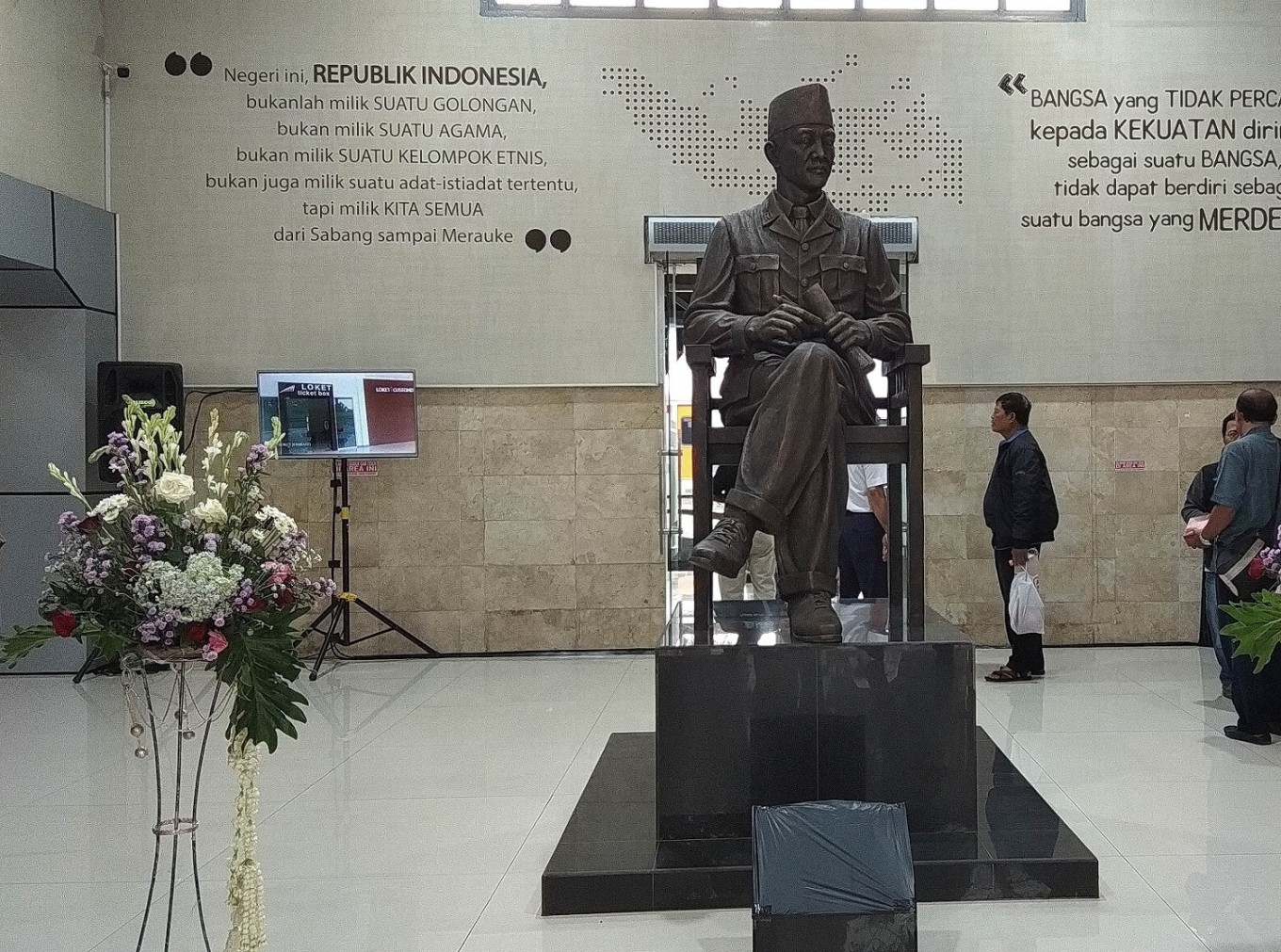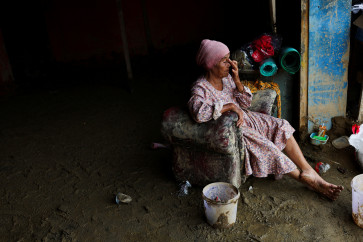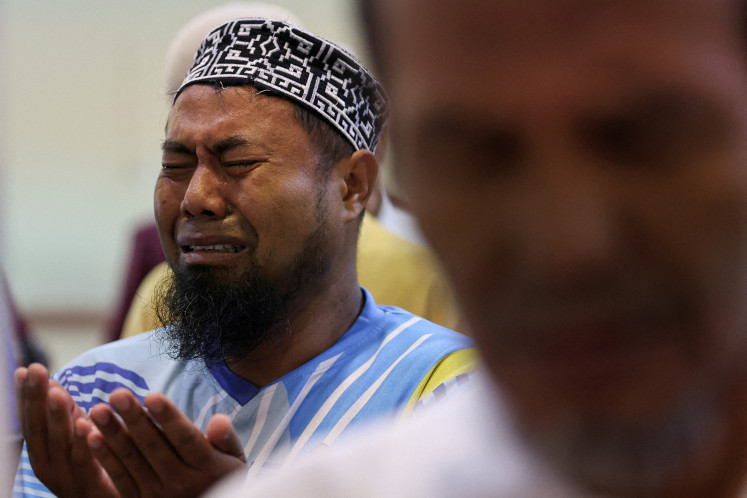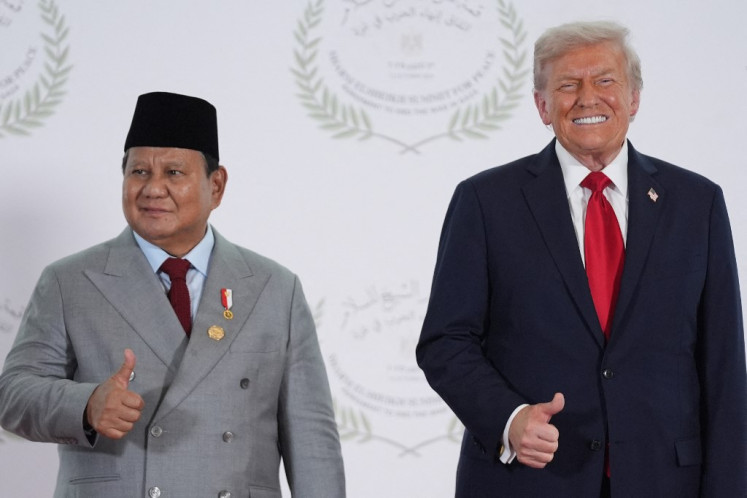Popular Reads
Top Results
Can't find what you're looking for?
View all search resultsPopular Reads
Top Results
Can't find what you're looking for?
View all search resultsEighth Sukarno statue cements founding president's influence in Blitar
In the eyes of historians, Blitar was not where Sukarno wanted to be buried.
Change text size
Gift Premium Articles
to Anyone
A statue of Indonesia's founding president Sukarno has been installed in the lobby of the Blitar railway station in East Java.
It is the eighth statue of Sukarno in the small city, where the first president's grave, known as Bung Karno's Grave, has become a tourist magnet since the fall of the second president Soeharto’s New Order regime.
The statue, made of resin with a scale of 1:1.6, depicts Sukarno sitting in a chair with his left hand holding a scroll containing Indonesia’s proclamation of independence. The statue was created by Balinese sculptor Ketut Winata.
“This is the first and only Bung Karno statue installed inside a railway station,” state-owned railway operator PT Kereta Api Indonesia (KAI) president director Edi Sukmoro told a press conference on Dec. 12 during its inauguration.
Edi said the decision to install Sukarno’s statue at Blitar Station was based on the fact that the president was buried in the city.
“Blitar is a special place. Sukarno’s grave is here in the city. With this statue, we hope that train passengers are inspired to visit the grave,” he said.
Sukarno was buried on June 22, 1970, next to the graves of his parents in Bendogerit subdistrict in Sananwetan district, the day after he died in Jakarta.
After Soeharto stepped down from his presidency in 1998, the number of tourists visiting Sukarno’s tomb continued to increase to this day. The government of Blitar seized the opportunity to strengthen the city’s brand as Bung Karno’s Land by building several statues of him.
Read also: 145-year-old Blitar coffee plantation lures tourists with colonial history, internship opportunity
However, in the eyes of historians, Blitar was not where Sukarno wanted to be buried.
Indonesian Institute of Sciences (LIPI) historian Asvi Warman Adam, for example, said the choice of Blitar as Sukarno’s burial place was based on Presidential Decree No. 44/1970 dated June 21, 1970. It was actually part of then-Army General Soeharto’s efforts to alienate Sukarno, even after his death, to distance him from the center of power in Jakarta.
In his book titled Bung Karno, Dibunuh Tiga Kali? (Bung Karno, Murdered Three Times?), published in 2010, Asvi wrote that according to his will, Sukarno wanted to be buried at the Bogor Presidential Palace complex in West Java.
In the book, Asvi concluded that there were three systematic efforts from the New Order regime led by Soeharto to "murder Sukarno".
First was the killing of Sukarno’s character by creating a narrative of his involvement in a failed coup on Sept. 30, 1965, or even his role as the mastermind. Second, after Soeharto officially became president in 1967, Sukarno was placed under house arrest at Bogor Palace and then moved to Wisma Yaso, Jakarta. The New Order’s regime did not provide adequate care when Sukarno fell ill under house arrest and until his death.
Third, attempts to kill Sukarno’s influences, including by burying him in Blitar. Though the choice of the city was justified by the fact that both Sukarno’s parents were also buried in Blitar, it is also part of the efforts to kill his character: by burying Sukarno in the same area where the Indonesian Communist Party (PKI) used to have a broad base of support, especially in the southern part of the city.
Bakung subdistrict, about 30 kilometers to the south of Blitar city, was the stronghold of PKI followers, where the party's figures from outside Blitar fled after the events of Sept. 30, 1965. In 1968, the Indonesian Armed Forces (ABRI) launched a “cleansing” operation for PKI members and their supporters in Bakung subdistrict and its surroundings, assisted by a number of youth organizations, including Anshor, which is affiliated with one of Indonesia's biggest Islamic organizations Nahdlatul Ulama (NU).
Two years after Sukarno’s death in 1970, the New Order regime built the Tugu Trisula monument in Bakung village, Bakung subdistrict, as a reminder of the operation.
During Soeharto’s rule under the New Order regime, which heavily relied on military power, the existence of Sukarno’s tomb in Blitar was not something that the local community could be openly proud of. During that period, only families and older generations who admired him regularly visited his grave.
The 1998 Reform Era triggered by student protests led to Soeharto’s resignation from the presidency he had occupied for 32 years. Megawati Soekarnoputri, Sukarno’s daughter, emerged as a leader and became the fifth president of Indonesia in 2001, replacing president Abdurrahman “Gus Dur” Wahid, who was impeached in the middle of his leadership.
Since then, community visits from various cities to Sukarno’s grave have continued to increase. The mayor of Blitar at that time, Djarot Saiful Hidayat, was one of the most important figures in encouraging the construction of Sukarno’s statues as an effort to strengthen Blitar as “Bung Karno’s Land.”
From 2000 to 2010, the first statues of Sukarno were constructed, including the one located inside his graveyard complex in Bendogerit. There, the statue, which portrays him sitting in a chair reading a book, was part of the Bung Karno Library’s construction in 2004.
The other statues are located in the lobby of Blitar’s mayor's office on Jl. Merdeka, on the pavilion of the Blitar regent’s official residence north of Blitar, at the intersection of Jl. Sumatra, in the courtyard of Gebang Palace and the largest one at 9 meters tall can be found at the intersection of Herlingga. It was inaugurated by Megawati in 2017.
One year later, the city administration constructed an even larger Sukarno statue, standing at 14 m tall. It is placed in front of the Blitar regent’s office in Kanigoro district.
The head of the Blitar Tourism and Culture Agency's tourism management division, Heru Santoso, confirmed that the statues in Blitar were all built after the Reform Era and have become part of efforts to strengthen the city’s image as a destination for “nationalism and educational tourism”, with Sukarno’s grave as the icon.
Heru said Sukarno’s grave has become an important driver of the city's local economy by attracting more and more tourists.
“On average, around 1,500 people visit Bung Karno's Grave each day. On quieter days, there may not even be 500 people, but during school holidays, the number can increase to more than 5,000 people a day,” Heru told the Post.
Besides building Sukarno statues, Heru said the administration also planned to add new destinations. The first site to be constructed is Gebang Palace, which was a house that once belonged to Sukarno’s parents, Soekemi Sosrodiharjo and Ida Ayu Nyuman Rai, on Jl. Sultan Agung.
“For the people of Blitar, Sukarno is not only the founder of the nation and independence [fighter] but also a figure that continuously brings blessings to our economy. Therefore, it is not too much that his statues are being built here, especially since he was also known as an art lover, including statues,” Heru said. (vel/kes)











